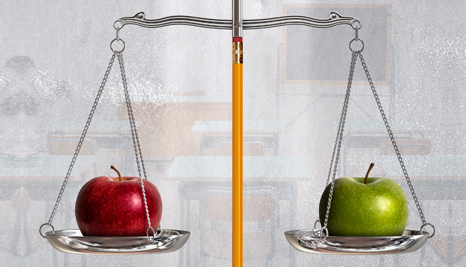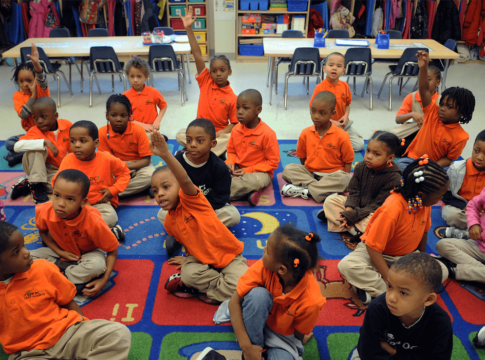Charter schools are revolutionizing public schooling in Washington, D.C. In just 18 years, charter schools have grown from an initial 5 to 112 schools today, managed by 61 nonprofit organizations. This school year, charters will serve nearly 38,000 students—44 percent of all public-school students in D.C. And these schools, which consistently outperform D.C. Public Schools (DCPS) overall and across all subgroups, offer students a tremendous variety of quality educational opportunities.
As the executive director and the board chairman of the District of Columbia’s independent chartering body, we are often asked whether we favor a “New Orleans” future for D.C., where charter schools eventually serve virtually all public-school students.
Our response may surprise some, but we do not. Rather, we see students and families in the District of Columbia better served with two thriving and successful sectors: charter and traditional public. Here’s why.
When Congress passed charter school legislation for Washington, D.C., in 1995, our public schools were a national disgrace, characterized by decrepit buildings, a meddling school board, patronage-based employment, sky-high truancy, and some of the nation’s lowest graduation rates and test scores. Enrollment in DCPS had fallen by nearly half from the mid-sixties, from 150,000 to just over 75,000 students.
The arrival of charter schools in 1996 offered parents another way out of a failing urban school system. No longer would they have to move to neighboring Maryland or Virginia in search of better public schools. For the first several years, charter schools added students as DCPS bled and cycled through a revolving door of leaders. After 10 years of charters and following the election of Mayor Adrian Fenty in 2006, DCPS was down to just 50,000 students, with charters claiming 20,000 students.
But something else happened. In part because of the growing popularity of charter schools, major reforms were made to DCPS:
· The district spent more than $2 billion on facilities improvements.
· Mayoral control replaced the elected school board.
· A path-breaking labor agreement ended seniority-based placement and tenure.
Most significantly, DCPS benefited over the past eight years from the uninterrupted strong leadership of two excellent chancellors—first Michelle Rhee and today Kaya Henderson. Two mayors and the city council gave these leaders the political cover, generous funding, and, perhaps most important, the time to make the improvements in people, systems, curriculum, and culture that are needed to turn around a failing institution.
Charter advocates have long hoped that competition from charters would spur improvement in traditional schools. In Washington, D.C., this has actually happened! Last year, DCPS was the fastest-improving major urban school district in the country. Charter schools keep improving as well due to the efforts of talented teachers and leaders, and the charter board’s aggressive closing of low performers.
Some have attributed these gains to a gentrifying city. But we see improvements across charters and DCPS for students in every group, including black (see Figure 1), Latino, low-income, and those with disabilities.

City residents are taking notice. Charters keep growing, but now DCPS is growing as well. For the first time since the Beatles appeared on the Ed Sullivan Show in 1964, total public-school enrollment in D.C. is rising.
We now have a virtuous cycle: growing enrollment and improving results in both the charter and traditional sectors.
Having two strong sectors is good for the city. It’s also good for charter schools.
Neighborhood Schools
One of the arguments for maintaining the traditional sector is that a lot of people like having neighborhood schools of right. They are usually close by, often walkable. They help create a community of neighbors. When the schools are good, they boost home values and attract new residents. Because admission is guaranteed, they take the anxiety out of school choice.
Neighborhood schools have also been associated with de facto segregation, as they reflect the demographics of their neighborhood. But integrated schools can be fostered by reserving slots for out-of-boundary children, and by the presence of a robust set of citywide schools of choice.
If charter schools took over the whole city, there would be tremendous pressure for them to become fully, or partly, neighborhood schools of right. That’s what we see in New Orleans, where half of the slots are reserved for neighborhood children and schools must accept new children at any time during the year.
We would rather not see that happen to D.C. charters. It would change their fundamental character as schools of choice, limit their educational and operational flexibility, make them harder to close for low performance, and open them to wider and wider regulation.
Turning charters into neighborhood schools could constrain their educational approaches. Charter schools that are immersive bilingual, have a military theme, offer a no-excuses culture, or promote a Waldorf philosophy where children do not begin reading until age seven all might be considered inappropriate for a neighborhood school that is the default choice for all neighborhood children.
Moreover, neighborhood schools are often heavily influenced by local community members, as opposed to parents, with concerns that can at times distract a school from the single-minded focus that we see in truly great schools.
And neighborhood schools take on a permanence that is out of keeping with the charter model. If a charter school is a neighborhood school, it may be more difficult to move the school out of the neighborhood, to a larger building, for example. And, from an authorizer’s perspective, it may be more difficult to close a low-performing neighborhood school because of the added community and political dimension involved.
New Orleans, of course, offers no true neighborhood schools of right. The solution there is to have large school zones within which certain students are given preference. That denies communities true neighborhood schools. But worse, it imposes new burdens and restrictions on charter schools.
For example, every charter school in New Orleans has been effectively deemed a school of right. Each must offer the same number of seats in every grade, and admit new students whenever a vacancy occurs, at any time of year (what some refer to as “backfilling” seats). This significantly limits the flexibility of charter school design and consequently reduces the choices available to parents and students. Immersive bilingual programs, for example, are more difficult to maintain with new monolingual students arriving midyear. D.C. has a highly successful college-prep charter high school that depends on a rigorous 9th-grade academy that prepares students for the rigors of grades 10 through 12. This model also works less well with students arriving midyear or after the 9th grade.
“Aha!” a charter opponent might say. “You are defending charter schools’ structural advantage over traditional schools. Why should only traditional schools bear the burden of being schools of right?”
Perhaps we are. But in a robust system of choice, parents should have real choices of high-quality alternatives, not various pastel versions of the same basic offering.
We should say that many D.C. charters embrace being open to all grades: some admit students midyear, and most have a mission to serve the city’s most disadvantaged students. The D.C. approach permits all sorts of models and allows many paths to success. Under a New Orleans scenario, only a few of these paths are allowed.
Two-Sector Advantage
The New Orleans model has other drawbacks. As charters approach 90 percent market share, the authorizer has standardized discipline rules, “spread around” special education students rather than offering them full choice, and imposed common admission procedures. All of these contribute to the homogenization of charter schools and limit the very essence of what makes charter schools so promising.
We are seeing some of this in Washington, D.C., too. Just in the past three years, new rules were enacted specifying how charter schools must evaluate their teachers and mandating prescribed systems for addressing truancy. ESEA (Elementary and Secondary Education Act) waiver rules were applied to D.C. charters, rather than exempting them as they were in many states. And there have been countless legislative proposals that would require charter schools, for example, to hire specific types of teachers, communicate with parents in specific ways, or limit their choice of which students to promote from grade to grade.
Having two strong systems reduces the pressure to regulate charter schools as though they were the only public schools in the city. It raises the odds that charter schools can retain the freedoms and flexibilities that underpin their success, and it provides families with more choice as they select among charters, a local neighborhood school, and other specialized DCPS options.
As the charter authorizer, our job is to keep our strong focus on quality—closing low-performing schools, helping promising schools improve, encouraging our best schools to expand, and applying rigorous oversight to approve only the most-promising new applicants. Our goal is not to “flood the zone” but to carefully and thoughtfully build a charter sector of unimpeachable quality that, along with DCPS, keeps improving and adding more families to the District.
Of course, it is easier to support a two-sector solution when we have a strong and successful traditional public-school system as a partner. If we were talking about a city with toxic education politics and a hopeless traditional school system, we might have a different view. But for Washington, D.C., we believe two strong sectors—charter and traditional—offer the best prospect that families will have many quality educational choices for their children.
This is part of a forum on charter schools. For an alternate take, please see “The New Orleans Case for All-Charter School Districts” by Neerav Kingsland.
This article appeared in the Summer 2015 issue of Education Next. Suggested citation format:
Pearson, S., McKoy, J.H., and Kingsland, N. (2015). How Many Charter Schools Is Just Right? Education Next, 15(3), 56-62.




